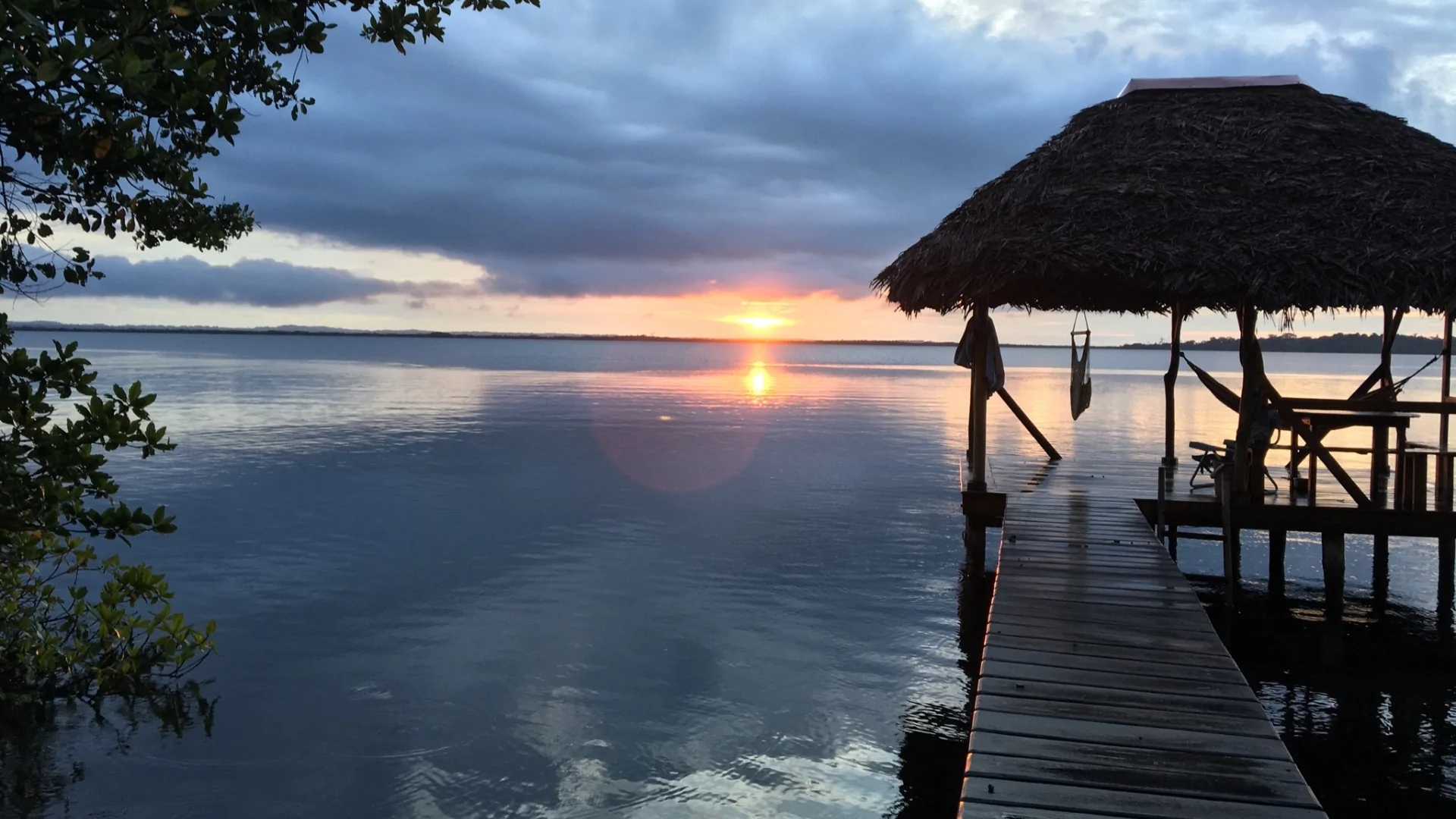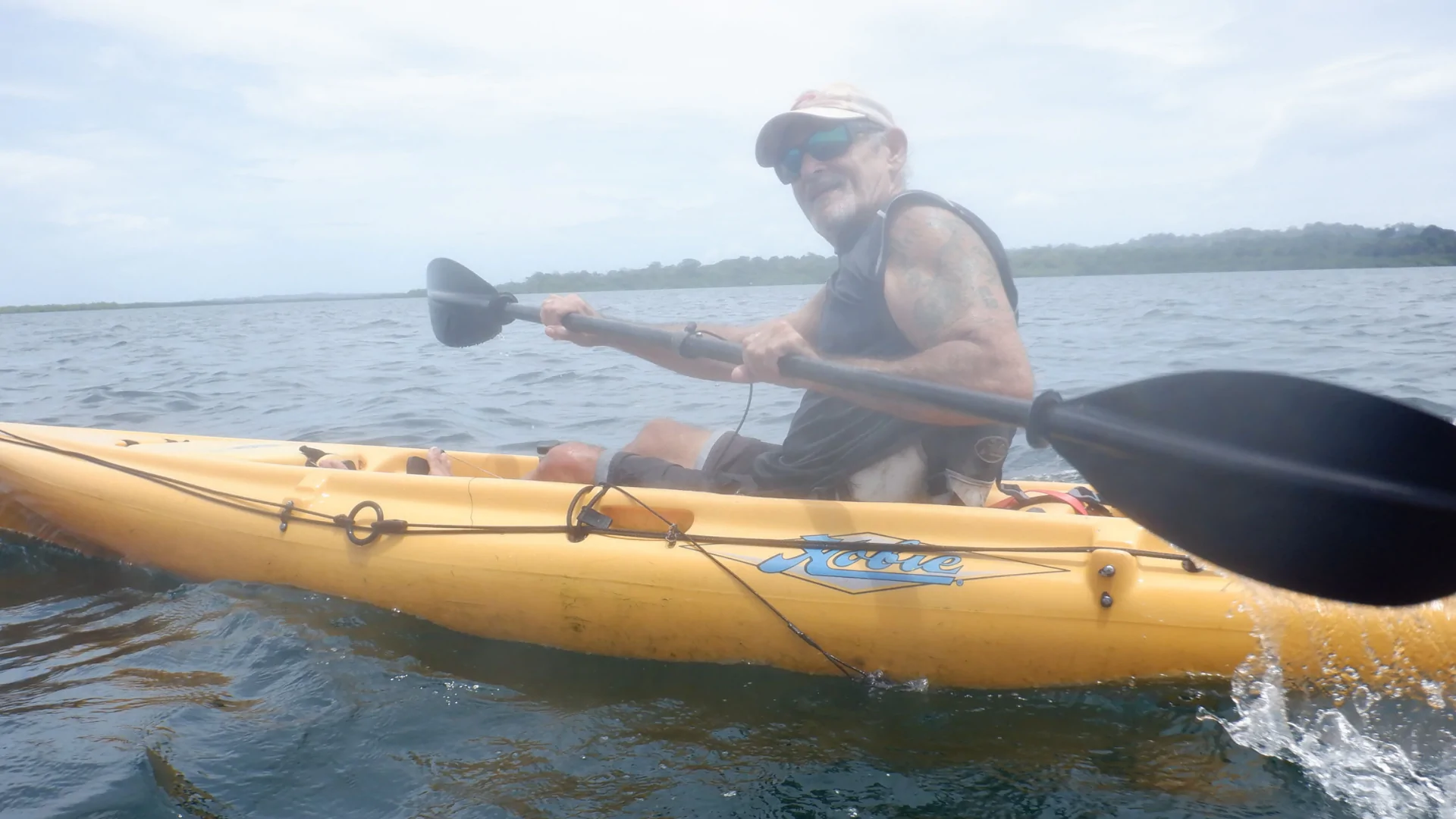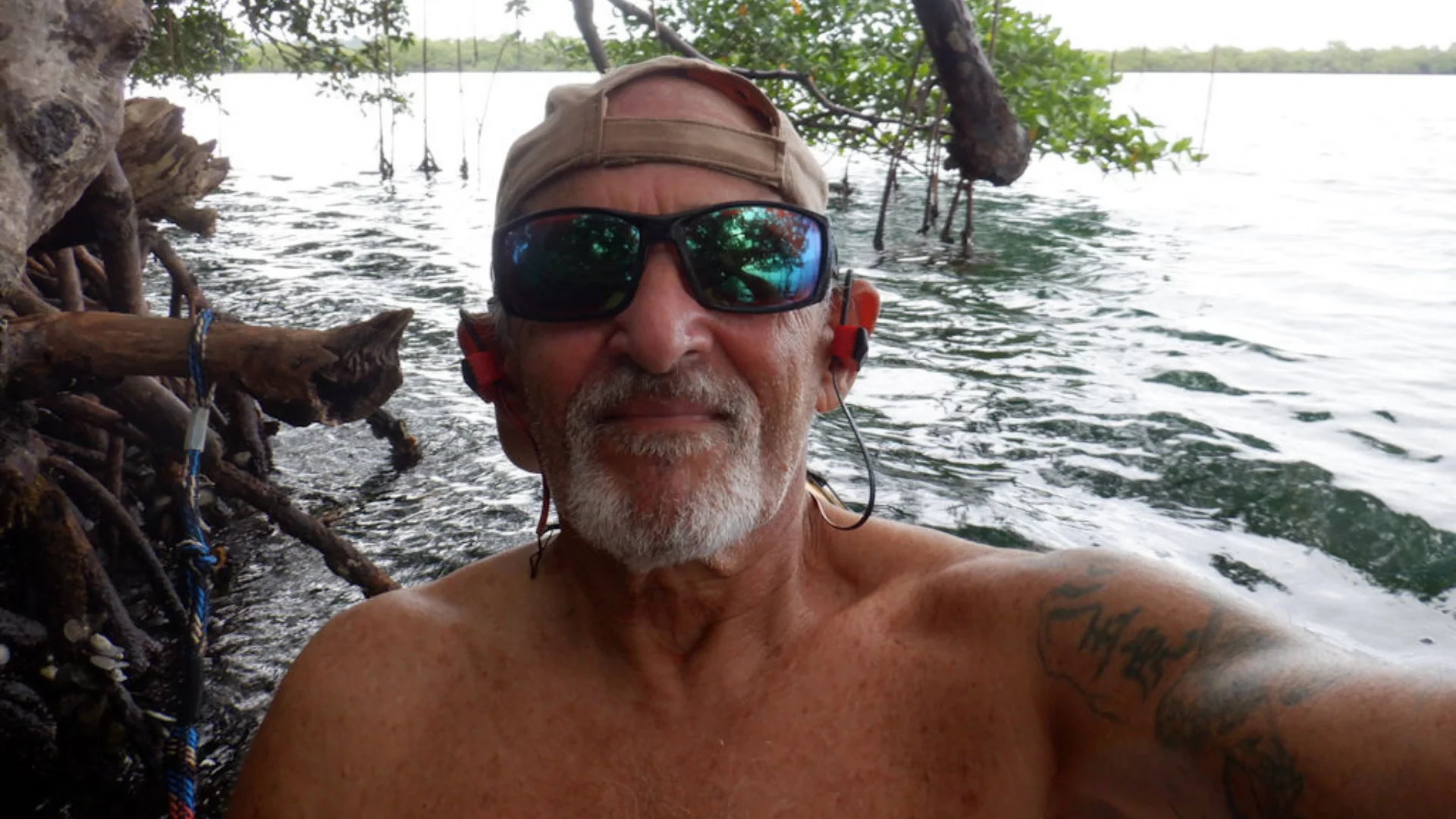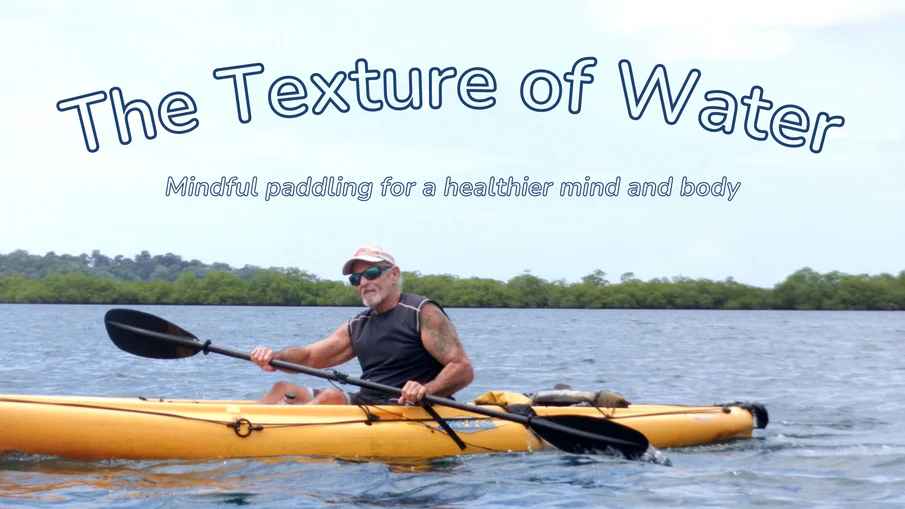Author: Dennis Waton
Bio: Born in Newark NJ. School at University of Missouri. A wanderer, I have lived and worked my way across the world. Love new cultures and adventures, and helping others. As a young man I had a rocky road with drugs and alcohol, but living in India put me on a better path, and I’ve never looked back. Currently paddling, meditating, and re-discovering veganism in Dolphin Bay, Panama, and happily searching for my next adventure.
The Texture of Water
Mindful paddling for a healthier mind and body
Let your body find its stroke:
Do you have physical challenges that you feel would make it difficult to paddle a kayak? Please read this short article. You can develop the techniques you will need to safely bring the freedom and joy of paddling into your life. First, a little setup:

I have been paddling across this magical bay in Panama 5 days a week for over five years. The title, the texture of water, comes from the view of the water as I paddle on a calm day. Looking across the bay at water level, you see what looks like many rivers running parallel to each other. Each holding water of a different texture on top. There can be five one morning and ten or more the next, and the size and shape vary. You can feel the current changes immediately as you cross the border from one section to the next. As the direction of the current changes, it can feel like paddling through glue one second and gliding free the next. As I crossed these divided waters, I have contemplated the paths I have traveled and hope to travel. They will remain a part of me.
I believe I have developed a better way to paddle for those who have had injuries or handicaps in our lives that make our bodies asymmetrical (maybe that includes everyone), and I would like to share what I have learned. I am a senior and have had many injuries in the construction field, including shoulder surgery, and when I add to that, fighting back the jungle here at Casa Mar y Selva in Dolphin Bay. I am asymmetrically balanced.
When I demoed my 1st kayak, I learned how to position and hold the paddle and the basic strokes. I was told to center the paddle on the top of my head with my arms at approximately a 90-degree angle gripping the paddle. They also showed me the paddling technique that uses the “paddlers box” to keep your body in position. That is the most efficient paddling system for young people without injuries or handicaps. By efficient, I mean the most distance for the least energy. I made sure my hands were in the proper position on the paddle and followed the traditional paddling technique. Being a little compulsive, I was correcting my hand position constantly. That was until I moved to this grand bay and developed another way to look at my paddling.
First, I wanted to make sure I was reaching my fitness goals. I found that breaking the paddlers’ box at the end of my stroke put natural stress on my arms, shoulders, and chest. That hits my upper body and gives me that pumped and toned look, especially after finishing a strong paddle. I began paying more attention to my legs and the power they create, pushing off the stroke. I also made sure my core was working hard, powering each stroke.

On a typical day, the currents pull against me in two directions going out. One is against me in the direction I am paddling, while the other pulls to one side. I use every bit of power I can generate to make the crossing. I listen to language lessons or music on the way out, paddle breathlessly with wind and waves that take 30 to 45 minutes to cross the bay, and pull behind a mangrove island out of the current and in the shade.
Wind and waves can make that part of the trip more work and more fun at the same time. In reality, the currents cause the most work, and the wind and waves cause the most fun. Exhilarating!
I enjoyed paddling mindfully, focusing on the points where my body connects to the boat. I didn’t pay attention to technique or the position of my body. Only the awareness of my hand on the paddle, my foot on the footrest, and my back moving across the seatback. It is very much like the different meditation techniques I have practiced. Instead of the breath, concentrate on where the hand ends and the paddle begins. I focus from hands to feet to back and let my mind clear. I hadn’t thought about my paddle position and stroke for a long time. I was only focusing on the connection of my body to the water.
After a bit of rest away from the currents and sun, I enjoy snorkeling and exploring the many mangrove islands. I also look forward to drinking some tea and sharing a little ganja with my native friends fishing in their cayucos.
If it’s a good day, the waves and wind will pick up a bit for the trip back. I enjoy meditation music (lately, Deva Premal’s Into Light and Love is Space albums). After working so hard to get out there, the trip back is about relaxing. You want to feel yourself and the boat as one, in tune with the waves and water textures. Once in a while, we get a big blow here. That makes for a great paddle home. There is nothing better than some rock-and-roll to help you dance those waves all the way home.
If I paddle slow enough, I can even get a free ride back on tiny waves. I paddle mindfully, letting the waves and currents do the work—very little energy needed for the trip home. I often focus on that small layer between where my hand ends and the paddle begins. I shift my attention to my feet on the pedals or my back against the seat as my torso twists. I drift in and out of a tranquil meditative state where the bay and I are present and without thought, only a physical and mental joy. The music adds to that joy, and as the waves and currents move the boat with only small automatic steering strokes, I feel like I am dancing on the waves.
A couple of years ago, I realized it had been a long time since I had paid attention to my hand positions and stroke. It surprised me to notice that the paddle on one side was at least double the length of the opposite side. Re-positioning my hands corrected the stroke, but that stroke would never feel right again. I couldn’t get comfortable. I can’t say how long I had been paddling that way, but it was too late now. My body had found its stroke.
For the next few months, I paid attention to the mechanics of my new paddling stroke. The long side worked as more of a corrective stroke against the current with a power assist from the triceps of the off arm when needed. As I entered strong currents, I was bouncing off my hips from side to side and bobbing up and down. This added bodyweight to the stroke and felt very comfortable and stable when needed. None of these changes were conscious decisions. My blades were super stable going through the water. On the short side of the paddle, the stroke was a plunge and hard pull close to the side of the boat. The rhythm of my strokes was being controlled by the force of the currents and waves. When riding the sea home, my weight and hips, and legs, as much as the paddles keep me going in the right direction
In the end, I guess I discovered that I now paddle with a limp. I’m a beat-up old man. Of course, I limp. After you hurt your leg, do you decide the mechanics of the limp you develop? Exactly what motion do you need to make? No, that is your body looking for the most stable and least painful way to complete its goal.
So that is it in a nutshell. Put in the time on the water. Relax, let your body find its stroke, and you can enjoy the freedom and joy of paddling mindfully.

I am now 70 years old and can paddle all day long. People with physical challenges can find joy and freedom, along with fitness and rehabilitation for their injuries by paddling. I am looking for one more big adventure in my life and helping people find their stroke, and the joy that is paddling needs to be the most significant part of it. They say the earth is 70% water. Grab a paddle.


0 Comments